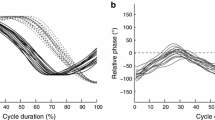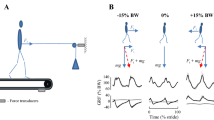Summary
Swimming in a mammalian quadruped, the rat, is analyzed in kinematic (joint angles) and electromyographic (EMG) terms. Data were collected on the movements of the hip, knee, ankle, and toe joints and three principle extensors and three flexors of the right hindlimb and compared with similar data collected on the same rats during treadmill stepping. The flexion, or protraction phase of swimming and stepping had many elements in common, including a similarity of EMG activity patterns and corresponding limb movements. However, in the extension, or retraction phase, there were notable differences. Although joint-extensor muscles were all coactive in both conditions, the brevity of the swimming extensor phase precluded the characteristic variation in EMG activity levels seen in the extensors in stepping. The flexors, in particular semitendinosus (ST), exhibited bursts of activity at the end of the extensor phase of swimming which were not present during the comparable period of stepping. The extra burst in ST produced a very rapid knee flexion at this time. Whereas the range of hip joint movement was similar in the two conditions, the ranges of the knee and ankle joints were expanded during swimming.
Overall, the evidence suggests that swimming is a very rapid form of a basic locomotor pattern in which the extensors are driven to their maximum contraction rate. The extra extension of the limb derives from the absence of ground reaction forces, allowing the knee and ankle joints to fully extend. The added bursts in the flexors remain to be explained. A discussion of these results in terms of current theories of single limb locomotor pattern generation is presented.
Similar content being viewed by others
References
Boylls C (1975) A theory of cerebellar function with applications to locomotion. II. The relation of anterior lobe climbing fiber function to locomotor behavior in the cat. COINS technical report 76–1, Dept. of Computer and Information Science, Univ. of Mass., Amherst
Duysens J, Stein RB (1978) Reflexes induced by nerve stimulation in walking cats with implanted cuff electrodes. Exp Brain Res 32: 213–224
Eccles RM, Lundberg A (1958) Integrative patterns of Ia synaptic actions on motoneurons of hip and knee muscles. J Physiol (Lond) 144: 271–298
Engberg I, Lundberg A (1969) An electromyographic analysis of muscular activity in the hindlimb of the cat during unrestrained locomotion. Acta Physiol Scand 75: 614–630
Garland H, Angel RW, Mellen RD (1972) A state variable averaging filter for EMG processing. Med Biol Eng 10: 559–560
Goldberger ME (1977) Locomotor recovery after unilateral hind- limb deafferentation in cats. Brain Res 123: 59–74
Gray J (1968) Animal locomotion. Weidenfeld and Nicholson, London
Grillner S (1975) Locomotion in vertebrates: Central mechanisms and reflex interaction. Physiol Rev 55: 247–304
Grillner S, Rossignol S (1978) On the initiation of the swing phase of locomotion in chronic spinal cats. Brain Res 146: 269–277
Grillner S, Zangger P (1975) How detailed is the central pattern generation for locomotion? Brain Res 88: 367–371
Grillner S, Zangger P (1979) On the central generation of locomotion in the low spinal cat. Exp Brain Res 34: 241–261
Gruner JA (1978) Cinematographic and electromyographic analysis of locomotion in normal and cerebellar irradiated rats. Ph. D. thesis, Department of Biological Sciences, Purdue Univ., West Lafayette
Gruner JA, Altman J, Spivack N (1980) Effects of arrested cerebellar development on locomotion in the rat: Electromyographic and cinematographic analysis. Exp Brain Res 40: 361–373
Lundberg A (1969) Reflex control of stepping. In: Nansen Memorial Lecture to Norwegian Academy of Sciences and Letters. Universitetsforlaget, Oslo, pp 1–42
Miller S, Burg J van der (1973) The function of long propriospinal pathways in the co-ordination of quadrupedal stepping in the cat. In: Stein RB, Pearson KG, Smith RS, Redford JB (eds) Control of posture and locomotion. Plenum Press, New York, pp 561–577
Miller S, Burg J van der, Meche FGA van der (1975) Coordination of movements of the hindlimbs and forelimbs in different forms of locomotion in normal and decerebrate cats. Brain Res 91: 217–237
Orlovsky GN, Pavlova GA (1972) Response of Deiters' neurons to tilt during locomotion. Brain Res 42: 212–214
Orlovsky GN, Shik ML (1965) Standard elements of cyclic movement. Biophysics 10: 935–944
Orlovsky GN, Shik ML (1976) Control of locomotion: A neurophysiological analysis of the cat locomotor system. Int Rev Physiol 10: 281–317
Pearson KG, Duysens J (1975) Function of segmental reflexes in the control of stepping in cockroaches and cats. In: Herman RM, Grillner S, Stein PSG, Stuart D (eds) Neural control of locomotion. Plenum Press, New York, pp 519–538
Perret C, Cabelguen JM (1976) Central and reflex participation in the timing of locomotor activations of a bifunctional muscle, the semitendinosus, in the cat. Brain Res 106: 390–395
Severin FV, Shik ML, Orlovsky GN (1967) Work of the muscles and single motor neurons during controlled locomotion. Biophysics 12: 762–772
Shik ML, Orlovsky GN (1976) Neurophysiology of locomotor automatism. Physiol Rev 56: 465–501
Wetzel M, Atwater A, Wait J, Stuart D (1976) Kinematics of locomotion by cats with a single hindlimb deafferented. J Neurophysiol 39: 667–678
Author information
Authors and Affiliations
Rights and permissions
About this article
Cite this article
Gruner, J.A., Altman, J. Swimming in the rat: Analysis of locomotor performance in comparison to stepping. Exp Brain Res 40, 374–382 (1980). https://doi.org/10.1007/BF00236146
Received:
Issue Date:
DOI: https://doi.org/10.1007/BF00236146




